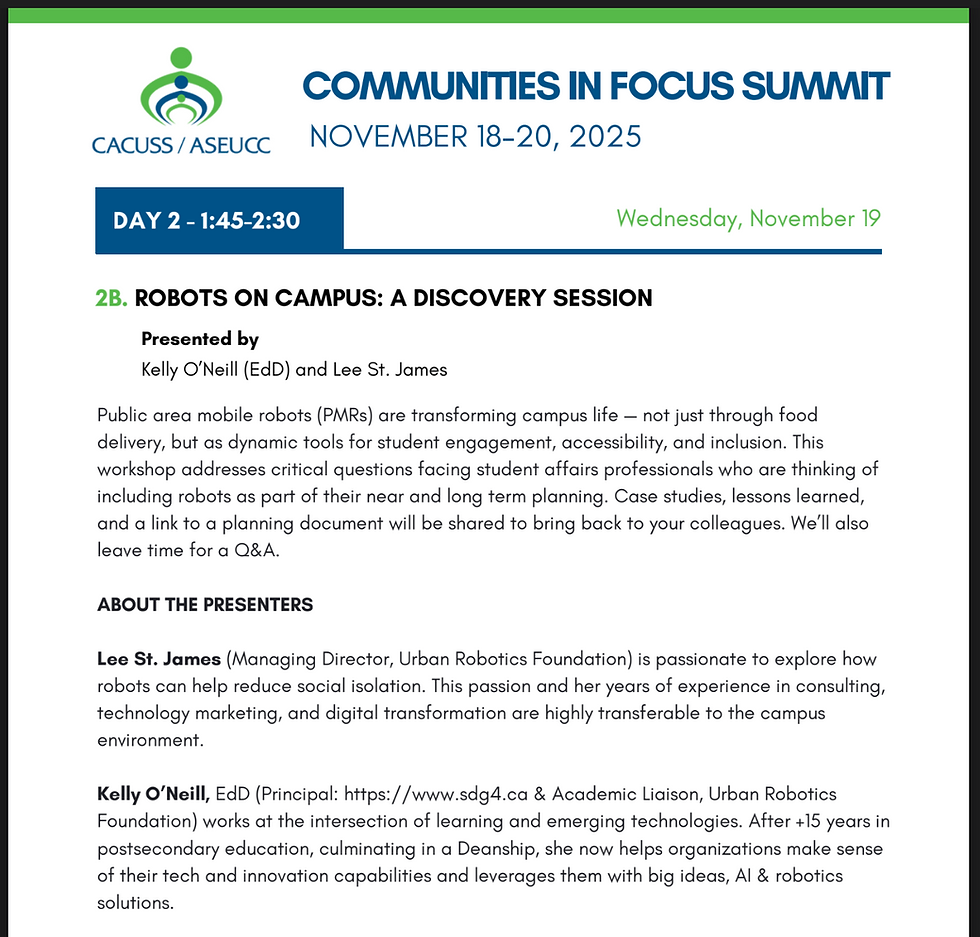Defining PMRs (from ISO DTS 4448-2)
- Sep 5, 2022
- 4 min read
Updated: Apr 26, 2023
2022 09 05 - Bern Grush (updated 2022 11 19)
This provides the Normative definition of "Public Mobile Robot (PMR)," used in Draft Technical Standard ISO 4448-2. It also provides an extended description.
The name Public Mobile Robot, was suggested by Aaron Prather to distinguish these machines from their older sisters "Industrial Mobile Robots." (Aaron is Director, Robotics & Autonomous Systems Program at ASTM International.)
In this article, the class of machines known as Automated Mobile Robots and sometimes as Autonomous Mobile Robots, breaks into at least two classes of machines: Industrial Mobile Robots and Public Mobile Robots.
The Normative definition for Public Mobile Robot in the draft ISO 4448 standard:
A Public mobile robot (PMR) is a wheeled or legged (ambulatory) ground-based device that is designed to travel along public, shared, pedestrianized pathways without the use of visible human assistance or physical guides.
notes:
Physical guides include rails, wires and/or kerbs
While the definition excludes devices with visible human assistance, PMRs can:
be teleoperated by a human
carry humans as passengers (e.g., a automated wheelchair)
be electronically tethered to follow a human
The longer explanation:
A PMR is a wheeled or legged (ambulatory) ground-based vehicle or device that operates in public, shared, pedestrianized spaces such as walkways, sidewalks, pavements, bike lanes, road shoulders, kerbs (curbs), parking lots, public areas of airports, hospitals, malls, public transportation stations, and is inclusive of devices which board and ride on transit vehicles or other platforms such as escalators, elevators, moving walkways, etc. The key distinction is that PMRs share space with and operate among non-involved, potentially vulnerable humans (and pets).

A PMR may perform tasks such as package, food or grocery delivery, automated passenger delivery, maintenance (sweeping, litter removal), winter maintenance (snow removal, brining), returning micro-mobility devices to their base (when passenger-less), ticketing parking violators, property or safety surveillance, advertising, tourist guidance, and many others.
From the perspective of the vulnerable user, the definition of PMR is inclusive of robotic roadway vehicles that operate to load and unload passengers and/or goods at the kerb (curb) such as robotaxis, shuttles and automated goods vans, and automated vans to move goods with incorporated delivery robots to local delivery locations. While the subject international standard addresses the loading and unloading of automated passenger and goods road-vehicles because proximate and potentially vulnerable humans may be involved during loading/unloading operations, it addresses no other aspect of their operation, manufacture or safety.
We avoid the use of terms such as sidewalk robot, footway robot, delivery robot, sidewalk drone, personal delivery device, micro-utility device, robot sweeper, surveillance robot, or robot snow plough within the Normative standard text as these terms are limiting, fashionable, of local usage, and continuously change. Nonetheless, the standard is inclusive of all these machine purposes and designs.
A PMR may or may not be constrained by a defined (geofenced) location. Any such location, however defined, is part of a PMR’s ODD.
A robotic device may be a PMR regardless of its level of automation or teleoperation, and regardless of its purpose or use. It does not matter if the PMR relies on all, some, or no artificial intelligence (AI). The term PMR may refer to a device that is entirely operated by radio control, fully autonomous, or may operate in some combination of these two modes.
This definition is agnostic with regard to the definition of artificial intelligence as well as to the level of autonomy or any claims of autonomy. Specifically, a PMR may operate in a completely automated manner (autonomous, SAE-J3016 Level 5), partly automated (standby teleoperation, fallback teleoperator, or remote oversight, SAE Levels 3 or 4), or under continuous teleoperation (SAE Levels 1 or 2).
While a PMR does not have a human operator on board, it may transport a human passenger such that said passenger is not operating the machine. Specifically, a wheelchair such that its occupying human is not in control and is not being guided or propelled by a proximate human helper is a PMR). A device that follows (without any physical connection) a human that may be walking or using a bicycle or other conveyance, by way of an electronic tether is a PMR by this definition.
PMRs are inclusive of machines and devices that move on a Pathway or ride on a mobile platform originally designed for human passengers without the visible aid of a proximate human operator (“unmanned’).
PMRs are exclusive of caged, fixed, or guided robots, where “guided” means some form of kerb, rail or magnetic guidance.
A PMR is a form of automated mobile robot (AMR) as originally defined for industrial environments such as warehouse or factory and is also known in those environments as an industrial mobile robot (IMR). While often similar in physical configuration or capability, a PMR is distinct from an AMR/IMR because of the operating domain of the PMR is inclusive of pedestrians of every age and ability, bicycles, wheelchairs, pets, parked and moving cars and possibly damaged, blocked, or within/on disturbed/damaged/poorly-maintained pedestrian infrastructure.
PMRs are not guided by magnetic rails or wires (these IMRs are known as Automated Guided Vehicles (AGVs) which are likewise out of scope).
There are critical operational distinctions and comparative deployment constraints between AMRs that operate in semi-structured spaces (warehouse, factory, farm) and PMRs that operate in unstructured—especially public, and pedestrianized—spaces. The term, PMR, recognizes that the context of the standard selects for public pedestrianized spaces but permits application anywhere else that is suitable, such as in malls, hospitals and other public-access building.




Comments